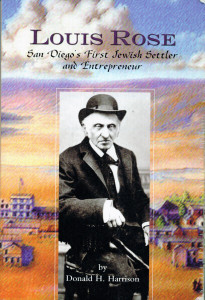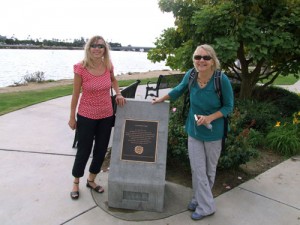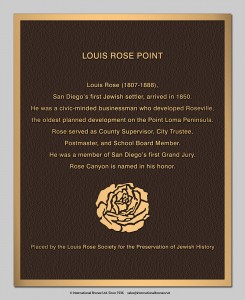Editor’s Note: In my quest to find Jewish stories wherever I go, I decided there is no place like home to illustrate the concept that “there is a Jewish story everywhere.” Interstate 8 roughly follows the traditional route that settlers took in their covered wagons in the mid-19th century to get to San Diego from the American Southeast. In this I-8 travel series, I have reversed their route traveling inland from the coast of California, heading east on the I-8 until I reach that freeway’s terminus in Arizona. Along the way, I will take readers to venues within a few miles of the freeway’s exits. Please note that over I-8’s California segment, the number designation of a freeway exit corresponds with that exit’s distance from the western terminus of I-8. Throughout this series, which we plan to run on Thursdays, we will use those numbers as aids to help our readers find the places we visit.
Interstate 8, Exit 2: Rosecrans Street
By Donald H. Harrison


SAN DIEGO — The Rosecrans exit from Interstate 8 leads to Loma Portal, Roseville, and La Playa, three neighborhoods of the larger Point Loma community of San Diego. To the west of Rosecrans Avenue is a high bluff leading through a United States government reservation to the Cabrillo National Monument, which commemorates the “discovery” of San Diego in 1542 by Portuguese navigator Juan Rodriguez Cabrillo, who was sailing in the service of Spain. As previously reported in this series, Cabrillo National Monument also can be approached from the Nimitz Boulevard exit of Interstate 8.
That “Roseville” and “Rosecrans” sound so similar is just a floral coincidence. William Rosecrans, for whom the street was named, was a gentile Civil War general who, following service in the Union Army, came to California with the idea of creating a San Diego terminus for a transcontinental railroad that would sweep across the southern states. However, Los Angeles, not San Diego, became the terminus.
The community of Roseville, on the other hand, was named for a visionary entrepreneur, Louis Rose, who in 1850 was the first Jew to settle in San Diego. Rose had grown up in the little town of Neuhaus-an-der-Oste in modern-day Germany, near the confluence of the Oste and Elbe Rivers close to the North Sea. He immigrated to the United States in 1840 settling first in New Orleans, and later making his way to Texas. Following news of the California gold discovery, he like many other merchants, continued westward to what became the Golden State. San Diego had just 650 residents when he settled there.
Then located under the Presidio hilltop, where Spanish soldiers in 1769 had built a mission and a fort, Old Town made no commercial sense from Rose’s standpoint. From his experiences on the Elbe River in Germany and the Mississippi River in the United States, Rose knew that ships and their cargo could mean trade and riches for any city.
Shaking his head over the fact that Old Town was located a couple of miles from the bay, instead of being situated alongside it, Rose decided to accumulate as much bayside property as possible between Old Town and the entrance to San Diego Bay to build a new town. Having accomplished that by 1869, he began selling lots in Roseville, an area 30 blocks long and stretching 8 blocks inland from the bay. The street that today is named Rosecrans Avenue, Rose had named Main Street. Cross streets that today are mostly named in alphabetical order for authors, he named more prosaically as 1st through 30th Streets.

In memory of Rose’s efforts to move San Diego’s location to the Bay from Old Town, a plaque has been placed at Louis Rose Point at a point where Roseville meets the Boat Channel leading into San Diego Bay.
Depite the magnificent views offered from the lots he carved out on the Pt. Loma hillside, Roseville was slow to develop. Investors preferred the New Town location across the bay that was chosen by private developer Alonzo Horton. Today, Horton’s Addition is the heart of San Diego’s downtown.
From his Roseville holdings, Rose sold for a nominal fee to the Jewish community’s its first cemetery (later moved to another part of the city), and gallantly presented residential lots to some of the women of San Diego with whose families he had dined during his bachelorhood.
Roseville was not the only geographic location where Rose left his name. In an area that once was known as La Cañada de las Lleguas, or the Canyon of the Mares, between Old Town and modern day La Jolla, Rose purchased property for San Diego’s first tannery. The area that became known as Rose Canyon is known especially to geologists because a well-known fault line runs through it. The small stream that runs through the canyon bears the name Rose Creek.
Trappers brought many animals with furs for tanning, sometimes paying money, and more often offering goods or livestock in trade. This was how Rose acquired his beloved Galapagos tortoise Chili, who was so big children could ride on its back. Rose and Chili and a small dog named Pat would take walks together, and Pat sometimes would bark seemingly ferociously at passing animals or humans. But when anyone approached Pat, the dog showed its true colors, skittering between the legs of Chil for protection.
Not wanting to waste any part of the cattle whose hides he tanned, Rose opened a butcher shop in Old Town, only one of his many enterprises. He also owned a small hotel, saloon, and a general store, and served as an officer of the would-be San Diego and Gila Railroad Company which hoped in vain to link up someday with a transcontinental line.
In Old Town San Diego State Historic Park, the two-story Robinson-Rose Building on the Plaza recalls Rose’s memory and that of James W. Robinson, a Texas politician whom he met on the wagon train to San Diego. Together, Rose and Robinson became powerful members of the San Diego City Board of Trustees as well as the first county Board of Supervisors.
Rose also served on San Diego’s first grand jury, and was an early member of the San Diego School Board. He was a member of San Diego’s first Masonic Lodge.
After his close friend Robinson died in 1857, Rose purchased the home from the widow Sara Robinson. Today that building serves as the State Park’s visitors center.
Besides providing upstairs living quarters for Rose and Mathilde Newman Rose, whom he married in 1869 when he was 62 years old, the building also provided offices for the Masons, for the railroad, and one year was used by Rose and his fellow Jews to conduct High Holy Day services.
It was there that Henrietta Rose, his spinster daughter, was born. Seven years after her father’s 1888 death she became a school teacher, serving the San Diego Unified School District for 45 years. In 1901, she was elected president of the San Diego chapter of the Eastern Star Masonic organization.
{Directions: Rosecrans Street is a westbound exit and eastbound entrance 0f Interstate 8. Rosecrans Street through the Point Loma Peninsula formerly was designated as State Route 209 South. To get to Louis Rose Point from the Rosecrans Street exit, continue straight and turn left onto Womble Street and follow it through the parking lot to the turnaround, and park. The marker honoring Rose is alongside a walkway adjacent to the boat channel.}
Next in the I-8 series: Mile 2, the University of San Diego (USD)
Harrison is editor of San Diego Jewish World. You may comment to him at donald.harrison@sdjewishworld.com, or post your comment on this website provided that the rules below are observed.
*
__________________________________________________________________
Care to comment? We require the following information on any letter for publication: 1) Your full name 2) Your city and state (or country) of residence. Letters lacking such information will be automatically deleted. San Diego Jewish World is intended as a forum for the entire Jewish community, whatever your political leanings. Letters may be posted below provided they are responsive to the article that prompted them, and civil in their tone. Ad hominem attacks against any religion, country, gender, race, sexual orientation, or physical disability will not be considered for publication. There is a limit of one letter per writer on any given day.
__________________________________________________________________

Interesting!!! I look forward to reading the whole series. Please post this on FB. — Mimi Pollack, La Mesa, California
Thanks Mimi, if you would like to post it on FB, simply copy the URL from the browser, and post it. That way, you can share it with your FB friends — Don Harrison, editor, San Diego Jewish World